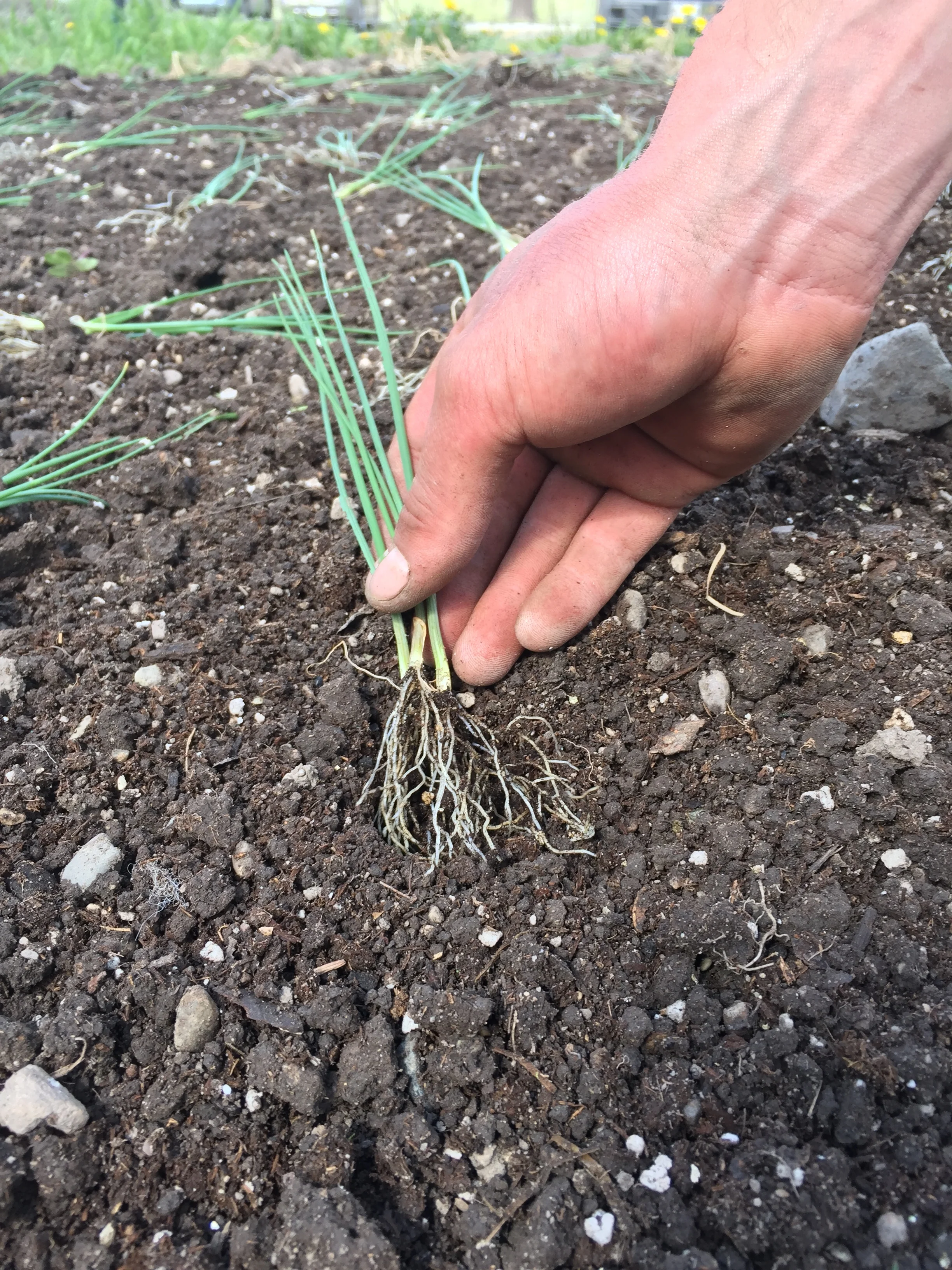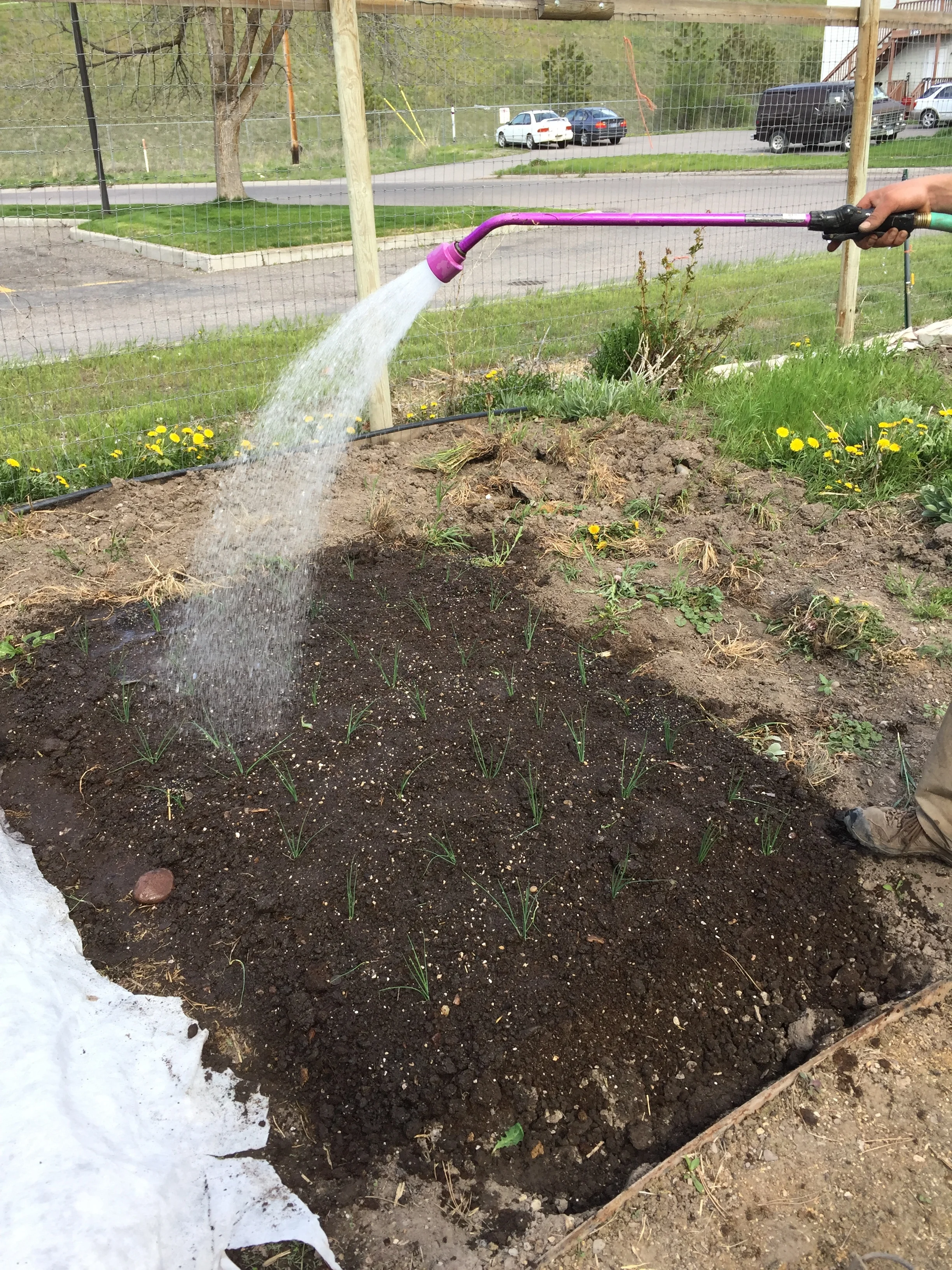Planting Superb Onions
Most people plant onions in rows, one at a time. At Garden City Harvest, we usually plant them in clusters or bunches. Onions are one of the first crops planted in the spring. They are the first in our greenhouses in March and the first in the fields in April or early May. If you plan on planting onions this spring, here are some secrets.
Step one: Pick a variety
A Garden City Harvest farmer carries a box of storage onion starts.
There are TONS of onion varieties from red to white to yellow, from scallions to shallots, and from fresh eating to storage varieties. Across our garden and farm sites, we grow a lot of storage onions: Dakota Tears, Ailsa Craig, Red Wing, and Patterson onions. Read our blog "The Onion Guide” for more on onion varieties and which we recommend. Generally, onions take a long time to grow (90-100 days), so in our climate it’s important to start onion seeds in early March in the greenhouse or buy starts in April from a local grower.
Step 2: Prepare the planting bed
Aim to create a nice, smooth, weed-free planting bed with soft soil for your baby onion starts. All onions and most of their relatives (leeks and shallots) are horrible sports about weeds and don’t compete well. Make sure to start with a weed-free bed when planting your onions and keep up on the weeding, especially when the onions are small and young. Aerate and loosen up the soil with a digging fork or shovel. This makes it easier to pull up weeds while also facilitating better root development for young plants and increasing water infiltration.
Onions are also heavy feeders and will benefit from soil amended with compost or manure. After weeding your bed and loosening the soil, spread a 1/4 inch of manure or compost evenly over the bed, break up any big clumps and rake smooth.
Step 3: Transplanting onion starts
Once the bed is prepped, it's time to plant the onion starts. Use the handle end of a rake or shovel to mark holes in the soil where you will plant your onions. Space the holes in your bed in a grid pattern —about 9 inches apart on all sides if planting multiple onions in a bunch like we do. You can also plant onion starts 4 to 6 inches apart if planting the onions individually in a row. Whether it's an indent or a line drawn in the soil, mapping out where you will be planting your starts is a good idea to make sure your spacing is correct.
Next, pop your onion starts out of the box or plastic container. Usually multiple onion starts are planted in one container, so you may have to stick a hand or trowel into a large clump of onions and grab a handful. Then, break apart that handful of onions into individual onion starts or smaller sets of 3 or 4. Now, lay out the bunch of 3 - 4 onions, where you made the holes in your bed as shown below. This helps you know if you have enough onions and/or holes in your bed.
The planting holes and baby onion bunches are prepped, laying on top of the soil before planting.
Holding the bunch of baby onions in one hand, use two fingers of the other hand (or a small trowel) to pull the soil back and plop the onion set in the hole. Onions should be planted deep—set the onions in the hole up to where the onion plant begins to divide into leaves, but not above. Also avoid bending the onion roots as much as possible by digging a deeper hole or trimming the roots to about 1 inch long. (Note: if you end up snipping the roots, make sure to snip 1/3 off the top of the onion too.)
Press the soil around the onions so they stand up right.
Step 4: Watering and fertilizing your onions
Before you go, make sure to water your baby onions well. It's natural for young plants to go through a little shock when first transplanted out into the garden, but the best way to mitigate shock is by watering your plants well. Also, if you can, choose to plant in the morning or evening or on a cloudy day when temperatures are cooler to minimize transplant shock.
Onions are also considered "heavy feeders" in the vegetable kingdom, which means they like a lot of nutrients and respond well to fertilizers high in nitrogen. While not necessary, applying liquid fish emulsion fertilizer once a week will help your onions grow big and strong.
Happy onion planting!
P.S. As your onion clumps mature, go ahead and harvest the big ones for your next dinner. Whichever ones you pick will only help the others grow bigger as well. Read more on harvesting and storing in our Onion Guide.





